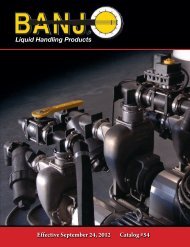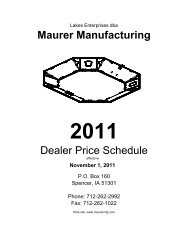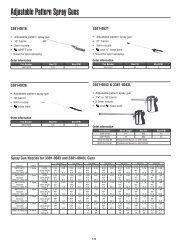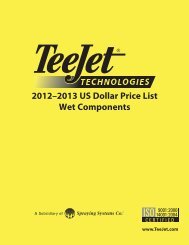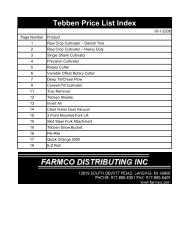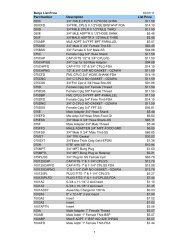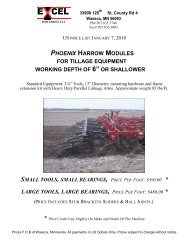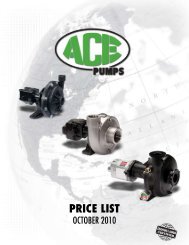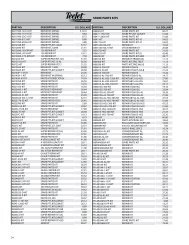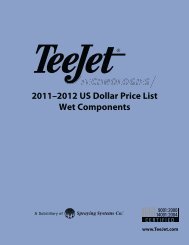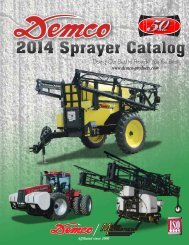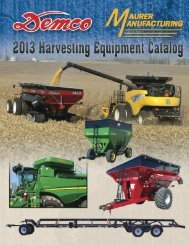Teejet Catalog 51 - Farmco Distributing Inc
Teejet Catalog 51 - Farmco Distributing Inc
Teejet Catalog 51 - Farmco Distributing Inc
Create successful ePaper yourself
Turn your PDF publications into a flip-book with our unique Google optimized e-Paper software.
Assessment of Nozzle Drift Control in Europe<br />
Several European countries now consider it important to assess<br />
nozzles for spray drift control as this enables general cooperation<br />
between agriculture, nature conservation and environmental protection.<br />
Although spray pattern distribution testing has been carried out<br />
for several decades (see page 134), preliminary assessment criteria<br />
for drift control during chemical applications were first defined in the<br />
1980’s and 1990’s. A minimum value was determined for the small<br />
droplet ratio (Dv0.1) of nozzles. The development of the XR TeeJet®<br />
nozzles, together with the first generation of drift control nozzles (DG<br />
TeeJet®), achieved significant advances in crop protection technology.<br />
However, these proved insufficient as environmental regulations<br />
on chemical application became more and more restrictive. Stricter<br />
requirements for buffer strips to protect surface water and sensitive<br />
areas around fields in particular have led to the development of a<br />
program that assesses nozzle drift control as well as to innovative<br />
nozzles producing larger droplet sizes. While nozzle development is<br />
described on pages 138 and 139, priority here is given to describing<br />
drift control evaluation programs.<br />
Drift control assessment systems in Europe<br />
Countries such as the UK, the Netherlands and Germany do not use<br />
standardized systems for measuring reduction in drift. However,<br />
one aspect shared by all systems is they all use a reference system<br />
based on the 03 nozzle specified in the BCPC droplet size classification<br />
scheme at 43.5 PSI (3 bar) pressure and at a spray height of 19.79<br />
(50 cm) above the target surface. Drift from this nozzle is defined as<br />
100%. The drift control levels from other nozzle types at the same<br />
pressure are compared with this reference nozzle. For example, a<br />
nozzle categorized as 50% produces at least 50% less drift than the<br />
reference nozzle. The countries mentioned above have compiled corresponding<br />
percentage drift control categories, which vary from one<br />
another in some areas and are valid only at a national level.<br />
While in Germany drift control categories of 50% / 75% / 90% /<br />
99% apply, they are categorized as 50% / 75% / 90% / 95% in the<br />
Netherlands and as 25% / 50% / 75% in the UK. Furthermore, the<br />
same nozzle type and size operated at the same pressure may be<br />
categorized as 50% in country A and 75% in country B. This is due to<br />
different methods of measurement and calculation. The future may<br />
lead to international standardization emerging over the next few<br />
years as a result of approaching EU harmonization. At present, TeeJet<br />
Technologies is obliged to test new developments and have them<br />
assessed in each of these countries to verify the effectiveness of the<br />
technical advances so farmers can use our products without fearing<br />
conflict with the government.<br />
The system in Germany<br />
In Germany, the Julius Kühn Institute-Federal Research Institute for<br />
Cultivated Plants (JKI), is responsible for testing nozzles for agricultural<br />
use. Drift measurements are taken in the field under the most<br />
standardized conditions possible for temperature, wind direction,<br />
wind velocity and forward speed. This method is mandatory for<br />
testing air-assisted sprayers and their affect on nozzles used on<br />
permanent crops such as orchards and vineyards. Thanks to field<br />
measurements recorded over many years and their high correlation<br />
with temperature-controlled wind tunnel measurements, drift measurements<br />
on agricultural nozzles can now also be conducted at the<br />
JKI wind tunnel in absolutely standardized conditions. In all cases,<br />
tracer methods are used to quantify droplets of a high detection<br />
limit on artificial collectors and feed the data into a “DIX model“ (drift<br />
potential index). This gives DIX values expressed as categories in the<br />
percentage drift reduction classes.<br />
The system in the UK<br />
The UK currently uses only one assessment system for agricultural<br />
nozzles. The Pesticide Safety Directorate (PSD) evaluates data<br />
recorded in the wind tunnel, but in contrast to the JKI, it records the<br />
droplets landed on horizontal collectors. The climatic conditions<br />
are standardized as well. The test nozzle is compared with the BCPC<br />
reference nozzle and awarded a corresponding star rating where one<br />
star equates to drift levels up to 75%, two stars up to 50% and three<br />
stars up to 25% of those of the reference system.<br />
The system in the Netherlands<br />
Although the Dutch have used an assessment system for agricultural<br />
nozzles for several years (Lozingenbesluit Open Teelten Veehouderij/<br />
Water Pollution Act, Sustainable Crop Protection), they are about to<br />
introduce a system for nozzles used in orchard spraying. Agrotechnology<br />
& Food Innovations B.V. (WageningenUR) is in charge of the<br />
measurements. A Phase Doppler Particle Analyzer (PDPA laser) is used<br />
to investigate the droplets and droplet speed from a nozzle offering<br />
the following characteristics: Dv0.1, VMD, Dv0.9 and volume fraction<br />



